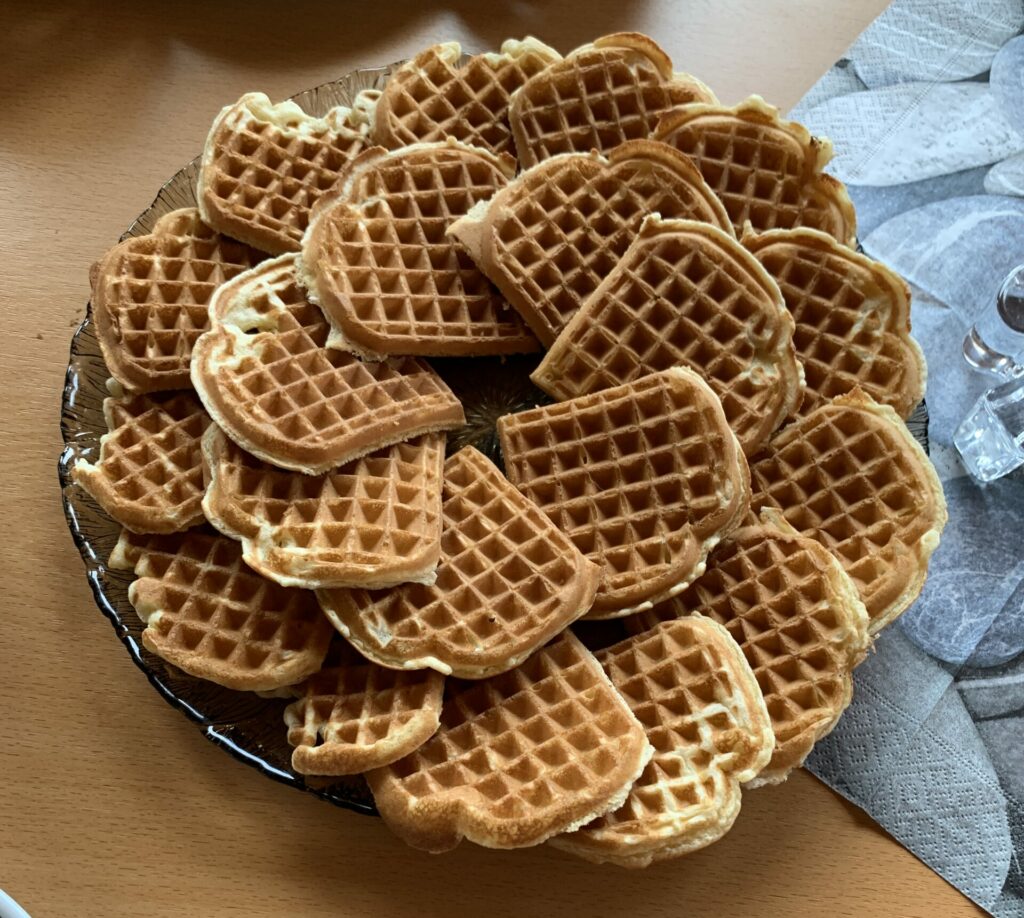Farmor (Grandma) and Farfar (Grandpa) always had homemade waffle batter in the fridge, ready to use. My brothers and I, who lived next door, had a standing invitation to come over for a waffle and a fairy tale from Farmor.
When we came running, she immediately plugged in the waffle iron, and shortly thereafter it was ready for use. Farmor and Farfar’s waffle iron had a color of red-orange lacquer in the middle, which gradually transitioned to black on the sides, and it balanced on the countertop on three small black legs.
Farmor took the batter out of the fridge, stirred a couple of times, and ladled a suitable amount into the waffle iron, where the batter assumed the classic shape of five pointy, perfectly connected hearts. A vaffelplate, or a vaffelkaka, as Farmor called it.
The wonderful, comforting smell of freshly made waffles rose from the hot iron as the batter was poured. The kitchen smelled of fresh waffles. It was the smell of an open house, hospitality, care, and love that spread in the room.
When I worked on the research report “Land, History and People: Older people’s Stories about Meaningful Activities and Social Relations in Later Life,” I became interested in waffles. When working on the data analysis, it became clear that preparing coffee and waffles was by far the most common example of activity and community initiatives in senior daycare centers, assisted living facilities, and nursing homes.
But it is not only within health care and senior care that coffee and waffles are a classic. At Nordland Research Institute, waffles are the surest way of getting people to show up to a department meeting, and waffles never fail to bring some welcome kos to Friday lunch hour. When the smell of waffles wafts through the corridors, the researchers come slinking out of their offices and allow themselves to gather and socialize with the group.
Not to mention football games, tournaments, raffles, end-of-school-year celebrations, band meets, election campaign stands, church coffee, and meetings of all the various teams and associations out there. There are waffles, always waffles, for young and old, with sugar or jam on top!
What is it that waffles actually mean to us, I wondered, and asked my colleagues about who serves them waffles, the word for waffles in their dialects, and their preferred toppings. My grandmother called them “vaffelkaka,” just as another grandmother from Sørfold called it “vaffelkak.”
A friend from Hardanger says “vaflo” in the definite singular. A friend from Helgeland likes to serve waffles with sour cream and smoked salmon. A divine combination of sweet and salty, a bit like the better-known custom of hot dog in a waffle in Østfold.
But even if there are regional variations in names and topping preferences, my impression is that the customs are still, for the most part, similar across the country.
It’s not like lefse, which comes in thousands of familiar, local and regional versions: potato lefse, tynnlefse (thin lefse), tjukklefse (thick lefse), mjuklefse (soft lefse), kling, or just lefse. Baked with or without potato, with or without baking powder, rolled out flat or made with a leveling agent to rise on the griddle, folded and served with or without brown cheese and cinnamon.
Other alternatives to waffles include lapper, common in Rogaland, sveler, a classic in the northwest, and in Tana, blood pancakes made from reindeer blood, an alternative rooted in local food traditions.
Isn’t there something very Norwegian about waffles? A concept that binds us together as one nation, across regional cultural differences? But, at the same time, so Norwegian that it can seem very ethnically specific to those of us who see the culture from the sidelines?
I have not found scientific articles specifically focused on waffles, but waffles appear in research on fishing crews, seamen’s churches, volunteer work, and integration. In the integration process, it is important that someone conveys information about what to do when you, as a parent, are told to bring waffle batter to a school event.
In these research contexts, waffles are mentioned as a symbol of hygge, social togetherness, taking the time for others, volunteering, Norwegianness, hospitality, community, and informality. Approachable politicians have made their share of waffles.
But as the waffle with coffee is so normal, so quick and easy to make, one might underestimate its importance. Making waffles at the senior center does not require a lot of extra equipment, expertise, or staffing. It also does not require much from the participants.
But it is not banal, not unimportant. The smell of waffles is an invitation to come and get together. It symbolizes community and hospitality, and it means that people at the nursing home – and people at Nordland Research Institute – will want to come out of their rooms, get together with the group, and have a chat.
Translated by Ragnhild Hjeltnes. Originally published at helgaeggebo.no/kom-og-fa-deg-ei-vaffel and reprinted by Bergen’s Tidende. This article originally appeared in the January 2024 issue of The Norwegian American.
Foto: Mariann Johansen Lindi
